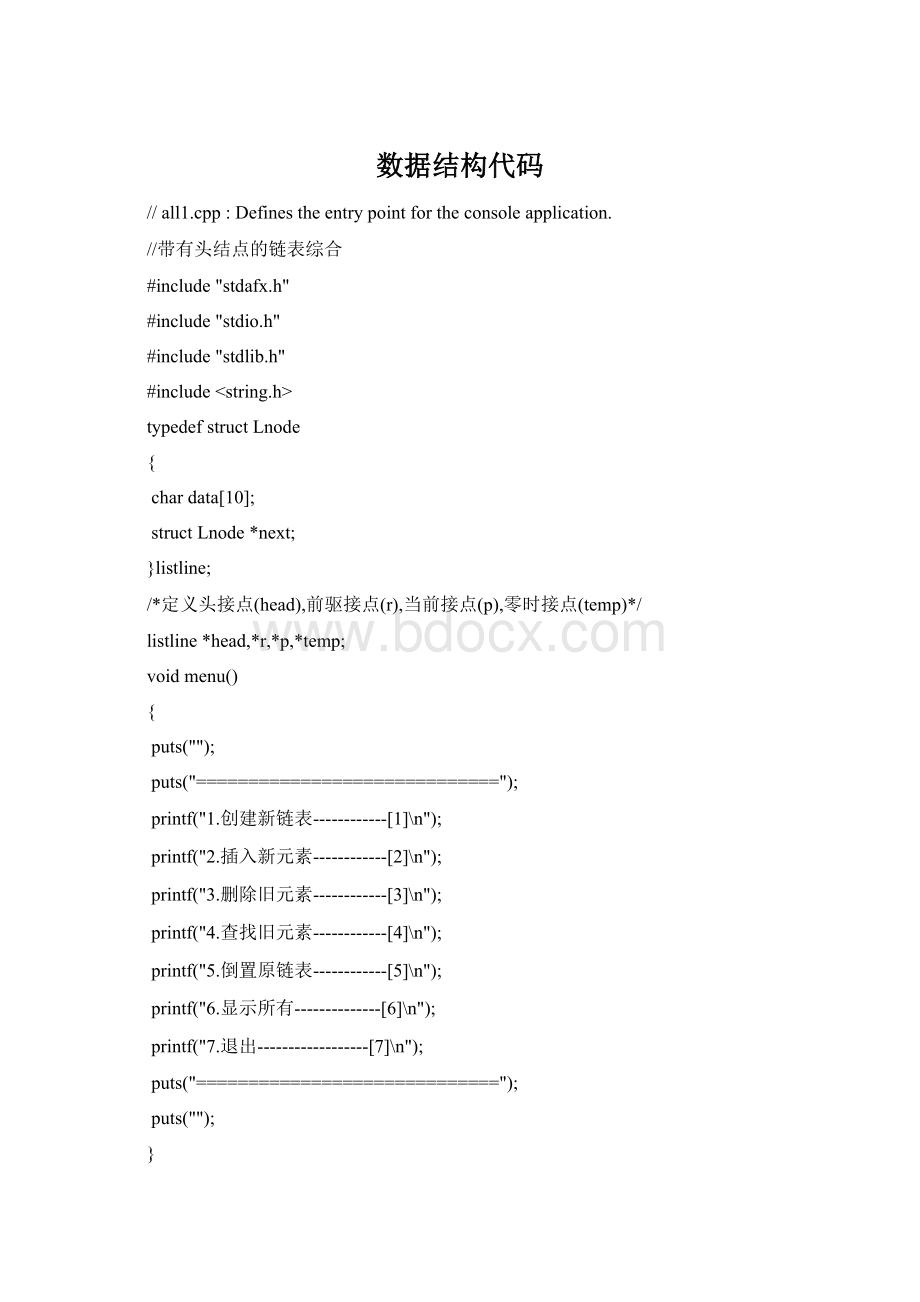数据结构代码.docx
《数据结构代码.docx》由会员分享,可在线阅读,更多相关《数据结构代码.docx(57页珍藏版)》请在冰豆网上搜索。

数据结构代码
//all1.cpp:
Definestheentrypointfortheconsoleapplication.
//带有头结点的链表综合
#include"stdafx.h"
#include"stdio.h"
#include"stdlib.h"
#include
typedefstructLnode
{
chardata[10];
structLnode*next;
}listline;
/*定义头接点(head),前驱接点(r),当前接点(p),零时接点(temp)*/
listline*head,*r,*p,*temp;
voidmenu()
{
puts("");
puts("=============================");
printf("1.创建新链表------------[1]\n");
printf("2.插入新元素------------[2]\n");
printf("3.删除旧元素------------[3]\n");
printf("4.查找旧元素------------[4]\n");
printf("5.倒置原链表------------[5]\n");
printf("6.显示所有--------------[6]\n");
printf("7.退出------------------[7]\n");
puts("=============================");
puts("");
}
voidcreater(inth)
{
inti;
if((head=(listline*)malloc(sizeof(listline)))==NULL)
{
printf("\n不能创建链表");
exit
(1);
}
r=head;
for(i=1;i<=h;i++)
{
if((p=(listline*)malloc(sizeof(listline)))==NULL)
{
printf("\n不能创建链表");
exit
(1);
}
p->next=NULL;
r->next=p;
printf("输入第%d个元素:
",i);
scanf("%s",&p->data);
r=p;
}
}
voidprint(void)
{
temp=head->next;
printf("\n");
while(temp!
=NULL)
{
printf("%s",temp->data);
temp=temp->next;
}
}
voidturnlist()
{/*倒置链表函数*/
r=head->next;
p=r->next;
r->next=NULL;
while(p!
=NULL)
{
temp=p->next;
p->next=r;
r=p;
p=temp;
}
head->next=r;
}
voidinsert(intn,charnewdata[10])
{
intj;
p=head->next;
j=0;
while(p&&j{
p=p->next;
j++;
}
r=(listline*)malloc(sizeof(listline));
strcpy(r->data,newdata);
r->next=p->next;
p->next=r;
}
voiddel_list(intn)
{
intj;
chare[10];
p=head->next;
j=0;
while(p&&j{
p=p->next;
j++;
}
r=p->next;
p->next=r->next;
strcpy(e,r->data);
free(r);
}
voidmain(void)
{
intselect,length,n;
charname1[10];
head=NULL;
while
(1)
{
menu();
scanf("%d",&select);
switch(select)
{
case1:
printf("\n请输入你要建立的链表的长度:
");
scanf("%d",&length);
creater(length);
printf("\n以下为你链表中的所有元素:
");
puts("");
print();
puts("");
printf("\n链表已创建,返回\n");
getchar();
puts("");
break;
case2:
if(head==NULL)
{
printf("\n请先建立链表,按任意键返回\n");
getchar();
break;
}
printf("请输入你要在第几个元素后面插入新元素:
\n");
scanf("%s",&n);
printf("请输入你要插入的新元素:
\n");
scanf("%s",&name1);
insert(n,name1);
printf("\n插入成功,以下为插入后的链表:
");
print();
puts("");
break;
case3:
if(head==NULL)
{
printf("\n请先建立链表,按任意键返回\n");
getchar();
break;
}
printf("请输入你要删除第几个元素:
\n");
scanf("%s",&n);
del_list(n);
printf("\n删除成功,以下为插入后的链表:
");
print();
puts("");
break;
case5:
if(head==NULL)
{
printf("\n\n出错,返回\n");
break;
}
else
{
printf("\n以下为原链表:
");
print();
printf("\n\n以下为倒置后的链表:
");
turnlist();
print();
printf("\n\n倒置成功,按任意键返回\n");
getchar();
break;
}
case6:
printf("\n以下为你链表中的所有元素:
");
puts("");
print();
puts("");
break;
case7:
exit(0);
puts("");
default:
printf("\n输入错误,请重新选择,返回\n");
getchar();
}
}
}
//text1.cpp:
Definestheentrypointfortheconsoleapplication.
//
#include"stdafx.h"
#include"stdio.h"
#include"stdlib.h"
#include"iostream"
usingnamespacestd;
#definestack_init_size100
#definestackincreament10
structSqstack
{
char*top;
char*base;
intstacksize;
};
voidinitstack(Sqstack&S)
{
S.base=(char*)malloc(stack_init_size*sizeof(char));
if(!
S.base)
puts("error");
S.top=S.base;
S.stacksize=stack_init_size;
}
voidpush(Sqstack&S,chare)
{
if(S.top-S.base>=S.stacksize)
{
S.base=(char*)realloc(S.base,(S.stacksize+stackincreament)*sizeof(char));
if(!
S.base)
puts("error");
S.top=S.base+S.stacksize;
S.stacksize+=stackincreament;
}
*S.top++=e;
}
voidpop(Sqstack&S,char&e)
{
if(S.top==S.base)
puts("error");
e=*--S.top;
}
intgettop(SqstackS,char&e)
{
if(S.top==S.base)
puts("error");
e=*(S.top-1);
return(e);
}
intempty(Sqstack&S)
{
if(S.top==S.base)
return1;
else
return0;
}
intmain()
{
structSqstackS;
charstr[20]={0};
initstack(S);
puts("输入一串表达式:
");
gets(str);
inti=0,flag1=0,flag2=0;
chare1,e2;
inta=-1;
while(a!
=1)
{
switch(str[i])
{
case'#':
a++;break;
case'(':
push(S,'(');break;
case'[':
push(S,'[');break;
case'{':
push(S,'{');break;
case')':
if(gettop(S,e1)=='(')
pop(S,e2);
else
push(S,')');
flag1=1;
break;
case']':
if(gettop(S,e1)=='[')
pop(S,e2);
else
push(S,']');
flag1=1;
break;
case'}':
if(gettop(S,e1)=='{')
pop(S,e2);
else
push(S,'}');
flag1=1;
break;
default:
break;
}
i++;
}
if(empty(S))
puts("表达式合法");
else
puts("表达式不合法");
}
//text1.cpp:
Definestheentrypointfortheconsoleapplication.
//
#include"stdafx.h"
#include"stdio.h"
#include"stdlib.h"
#include"iostream"
usingnamespacestd;
#definestack_init_size100
#definestackincreament10
structSqstack
{
int*top;
int*base;
intstacksize;
};
voidinitstack(Sqstack&S)
{
S.base=(int*)malloc(stack_init_size*sizeof(int));
if(!
S.base)
puts("error");
S.top=S.base;
S.stacksize=stack_init_size;
}
voidpush(Sqstack&S,inte)
{
if(S.top-S.base>=S.stacksize)
{
S.base=(int*)realloc(S.base,(S.stacksize+stackincreament)*sizeof(int));
if(!
S.base)
puts("error");
S.top=S.base+S.stacksize;
S.stacksize+=stackincreament;
}
*S.top++=e;
}
voidpop(Sqstack&S,int&e)
{
if(S.top==S.base)
puts("error");
e=*--S.top;
}
voidgettop(SqstackS,int&e)
{
if(S.top==S.base)
puts("error");
e=*(S.top-1);
}
intempty(Sqstack&S)
{
if(S.top==S.base)
return1;
else
return0;
}
intmain()
{
structSqstackS;
initstack(S);
inta,b=0;
puts("pleaseenteranumberyouwanttochange");
scanf("%d",&a);
puts("enteraHexadecimalnumbersyouwant");
scanf("%d",&n)
while(a)
{
push(S,a%n);
a=a/n;
}
while(!
empty(S))//用while输入所有的数据
{
pop(S,b);
cout<}
return1;
}
//text1.cpp:
Definestheentrypointfortheconsoleapplication.
//
#include"stdafx.h"
#include"stdio.h"
#include"stdlib.h"
#include"iostream"
usingnamespacestd;
typedefstructQnode
{
chardata;
structQnode*next;
}Qnode,*QueuePtr;
typedefstruct
{
QueuePtrfront;
QueuePtrrear;
}LinkQueue;
charinitQueue(LinkQueue&Q)
{
Q.front=Q.rear=(QueuePtr)malloc(sizeof(Qnode));
if(!
Q.front)
printf("error/n");
Q.front->next=NULL;
return1;
}
charDestoryQueue(LinkQueue&Q)
{
while(Q.front)
{
Q.rear=Q.front->next;
free(Q.front);
Q.front=Q.rear;
}
return1;
}
charEnQueue(LinkQueue&Q,chare)
{
p=(QueuePtr)malloc(sizeof(Qnode));
if(!
p)
puts("error");
p->data=e;
p->next=NULL;
Q.rear->next=p;
Q.rear=p
return1;
}
charDeQueue(LinkQueue&Q,char&e)
{
if(Q.front==Q.rear)
puts("error");
p=Q.front->next;
e=p->data;
Q.front->next=p->next;
if(Q.rear==p)
Q.rear=Q.front;
free(p);
return1;
}
voidmian(void)
{
}
二叉树
1.对题目要有需求分析
在需求分析中,将题目中要求的功能进行叙述分析,并且设计解决此问题的数据存储结构,设计或叙述解决此问题的算法。
给出实现功能的一组或多组测试数据,程序调试后,将按照此测试数据进行测试的结果列出来。
如果程序不能正常运行,写出实现此算法中遇到的问题和改进方法;
2.对题目要有相应的源程序
源程序要按照写程序的规则来编写。
要结构清晰,重点函数的重点变量,重点功能部分要加上清晰的程序注释。
(注释量占总代码的四分之一)
程序能够运行,要有基本的容错功能。
尽量避免出现操作错误时出现死循环;
3.最后提供的主程序可以象一个应用系统一样有主窗口,通过主菜单和分级菜单调用课程设计中要求完成的各个功能模块,调用后可以返回到主菜单,继续选择其他功能进行其他功能的选择。
二叉树的建立与遍历
[问题描述]
建立一棵二叉树,并对其进行遍历(先序、中序、后序),打印输出遍历结果。
[基本要求]
从键盘接受输入,以二叉链表作为存储结构,建立二叉树,并对其进行遍历(先序、中序、后序),将遍历结果打印输出。
以下是我的数据结构实验的作业:
肯定好用,里面还包括了统计树的深度和叶子数!
记住每次做完一个遍历还要重新输入你的树哦!
#include"stdio.h"
#include"string.h"
#defineNULL0
typedefstructBiTNode{
chardata;
structBiTNode*lchild,*rchild;
}BiTNode,*BiTree;
BiTreeCreate(BiTreeT){
charch;
ch=getchar();
if(ch=='#')
T=NULL;
else{
if(!
(T=(BiTNode*)malloc(sizeof(BiTNode))))
printf("Error!
");
T->data=ch;
T->lchild=Create(T->lchild);
T->rchild=Create(T->rchild);
}
returnT;
}
voidPreorder(BiTreeT){
if(T){
printf("%c",T->data);
Preorder(T->lchild);
Preorder(T->rchild);
}
}
intSumleaf(BiTreeT){
intsum=0,m,n;
if(T){
if((!
T->lchild)&&(!
T->rchild))
sum++;
m=Sumleaf(T->lchild);
sum+=m;
n=Sumleaf(T->rchild);
sum+=n;
}
returnsum;
}
voidzhongxu(BiTreeT){
if(T){
zhongxu(T->lchild);
printf("%c",T->data);
zhongxu(T->rchild);
}
}
voidhouxu(BiTreeT){
if(T){
houxu(T->lchild);
houxu(T->rchild);
printf("%c",T->data);
}
}
intDepth(BiTreeT){
intdep=0,depl,depr;
if(!
T)dep=0;
else{
depl=Depth(T->lchild);
depr=Depth(T->rchild);
dep=1+(depl>depr?
depl:
depr);
}
returndep;
}
main(){
BiTreeT;
intsum,dep;
T=Create(T);
Preorder(T);
printf("\n");
zhongxu(T);
printf("\n");
houxu(T);
printf("\n");
sum=Sumleaf(T);
printf("%d",sum);
dep=Depth(T);
printf("\n%d",dep);
}
二叉树2
/*二叉树的建立与遍历*/
#include
#include
typedefintEtype;
typedefstructBiTNode/*树结点结构*/
{Etypedata;
structBiTNode*lch,*rch;
}BiTNode;
/*函数原形声明*/
BiTNode*creat_bt1();
BiTNode*creat_bt2()
voidinorder(BiTNode*p);
voidnumb(BiTNode*p);
BiTNode*t;intn,n0,n1,n2,;
/*主函数*/
main()
{charch;intk;
do{printf("\n\n\n");
printf("\n\n1.建立二叉树方法1");
printf("\n\n2.建立二叉树方法2");
printf("\n\n3.中序递归遍历二叉树");
printf("\n\n4.计算树中结点个数");
printf("\n\n5.结束程序运行");
printf("\n======================================");
printf("\n请输入您的选择(1,2,3,4,5,6)");scanf("%d",&k);
switch(k)
{case1:
t=creat_bt1();break;/*调用性质5建立二叉树算法*/
case2:
t=creat_bt2();break;/*调用递归建立二叉树算法*/
case3:
{inorder(t);/*调用中序遍历*/
printf("\n\n打回车键,继续。
“);ch=getch();
}break;
case4:
{n=0;n0=0;n1=0;n2